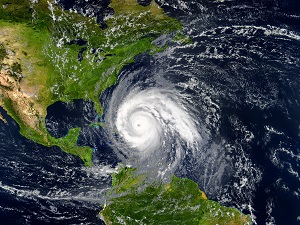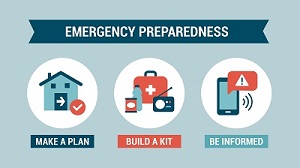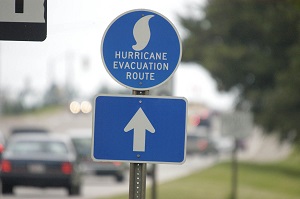Hurricanes are storm systems with circulating air and sustained wind speeds of 74 miles per hour or higher. The strongest hurricanes can have wind speeds exceeding 155 miles per hour. Hurricanes are dangerous and can cause major damage because of storm surge, wind damage, rip currents and flooding. Storm surge is historically the leading cause of hurricane-related deaths in the United States.

Areas on the Atlantic Coast, near the Gulf of Mexico, as well as parts of the Southwestern United States are vulnerable to hurricanes. Hurricane season is May 15th to November 30th and peaks between August and October.
During and after a hurricane, you may need supplies to keep your family safe and healthy. Remember that a hurricane could cut off your power and water supply. You may not be able to drive because of damage to your vehicle and roads may be flooded or blocked.
If you live in an area that might be impacted by a hurricane, prepare an emergency supply kit ahead of time. Keep this kit in a designated place and have it ready in case you have to leave your home quickly. Make sure all family members know where the kit is kept.
Listen for National Weather Service alerts on TV or radio or check for them online. There are two kinds of alerts:
- A hurricane watch means hurricane conditions are possible.
- A hurricane warning means hurricane-force winds are expected.
The Saffir-Simpson Hurricane Wind Scale is a 1 to 5 rating based on a hurricane's sustained wind speed. This scale also estimates potential property damage. Hurricanes reaching Category 3 and higher are considered major hurricanes because of their potential for significant loss of life and damage. Category 1 and 2 storms are also dangerous and require preparatory measures.

If a hurricane is a possibility in your area, get prepared and tune in for local weather information.
Get your family and pets ready.
- Write down emergency phone numbers, keep them handy and also program them into your cell phone.
- Go over the emergency plan with your family and gather emergency supplies.
- Keep checking for updates about the storm. Watch TV, listen to the radio, or check online.
- If needed, call the hospital, public health department, or the police about special needs. If you or a loved one is older or disabled and won’t be able to leave quickly, get advice on what to do.
- Put pets and farm animals in a safe place.
- Locate the nearest shelter and different routes you can take to get there from your home. If shelter locations in your area have not been identified, learn how to find them in the event of a storm.
- Know how to turn off your gas, electricity, and water in case you need to evacuate.
- Be prepared to follow instructions from the local authorities and to evacuate if instructed to do so.
Get your home ready.
- Clear your yard. Make sure there’s nothing that could blow around during the storm and damage your home.
- Cover windows with storm shutters or plywood. This can help keep you safe from pieces of shattered glass.
- Be ready to turn off your power. If you see flooding, downed power lines, or if you have to leave your home, switch your power off.
- Fill clean water containers with drinking water. You’ll want to do this in case you lose your water supply during the storm. You can also fill up your sinks and bathtubs with water for washing.
- Check your carbon monoxide (CO) detector’s battery to prevent CO poisoning.
Get your vehicle ready.
- Fill your gas tank.
- Move cars and trucks into your garage or under cover.
- Prepare an emergency kit for your vehicle.
- If you don’t own a car, consider making plans with friends or family or call authorities to get a ride if you need to evacuate.

If you need to evacuate:
- Grab your emergency supply kit and only take what you really need with you.
- Unplug your appliances and if you have time, turn off the gas, electricity, and water.
- Follow the roads that emergency workers recommend even if there’s traffic. Other routes might be blocked or flooded.
- Never drive through flooded areas—cars and other vehicles can be swept away or may stall in just 6 inches of moving water.
If you need to stay home:
- Make sure your emergency supply kit is easily accessible.
- Listen to the radio or TV for updates on the hurricane.
- Stay inside. Even if it looks calm, don’t go outside. Wait until you hear or see an official message that the hurricane is over. Sometimes, weather gets calm in the middle of a storm but then quickly gets bad again.
- Designate a shelter area if you can’t evacuate. Rooms without windows are best. Stay away from windows—you could get hurt by pieces of broken glass or flying debris during a storm.
- Be ready to leave. If emergency authorities order you to leave or if your home is damaged, you may need to go to a shelter, a hotel, or other location that is safer.


.jpeg)
